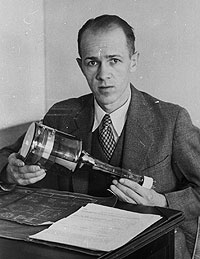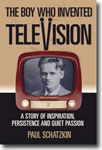

 |
The Farnsworth
Invention: Fact -v- Fiction
|
 |
Act II, Scene 3: In which secrets are revealed - and stolen |
| The Play |
The Facts
|
|
We are now ready for our hero to meet his nemesis. As the scene opens, we find Farnsworth in a bar, where, once again, he is getting hammered. Only, who should show up at the bar beside him but... Vladimir Zworykin, the engineer from Westinghouse, the man whose patent for electronic television has been in limbo for at least seven years. . |
The idea that Farnsworth and Zworykin first met in a bar is simply ludicrous. But they did meet, in the spring of 1930, and Farnsworth did show Zworykin his Image Dissector tube. Still, many important details are left out of this pivotal scene. Most importantly: when Zworykin arrived at Farnsworth's lab in April 1930, he arrived under the pretense of investigating a possible patent license for Westinghouse. Under that assumption, it was normal and reasonable for Farnsworth to be as forthcoming as possible. There was no mention of where Zworykin was headed once he left San Francisco. |
|
| Once Farnsworth, Zworykin, and the lab gang have assembled at the lab, Zworykin is shown how an Image Dissector tube is constructed. | Experts at the time contended that it was impossible to seal a flat optical disk into the end of a vacuum and not have it implode when the air was pumped out. All early vacuum tubes had domed ends, including the first Image Dissectors. Cliff Gardner devised a novel way of doing what others had said was impossible. Not knowing what others said couldn't be done, he just went ahead and did it. |
 Cliff Gardner, with one of his "impossible" Image Dissector tubes |
| Zworykin is shown a complete Image Dissector. | When he was handed the completed Image Dissector tube, Vladimir Zworykin, the man who wished he could invent television, said one of the most important lines that has not made it into the dialog of this play: "This is a beautiful instrument, I wish that I might have invented it." Knowledgeable authorities disagree whether Zworykin meant what he said or was merely being polite to his host, but there is no disputing the statement, which was made in front of numerous witnesses who so testified in subsequent litigation. That the line is left out of the play is a bold omission of an essential line of dialog. |
|
The scene at the lab with Zworykin is interrupted when Phil's sister rushes in to announce an emergency. At a hospital, Farnsworth learns that his infant son Kenny's stept throat has spread to his lungs. The baby can't breathe, and an emergency tracheotomy is required. Anguish ensues.
|
On March 6, 1932, Kenneth Gardner Farnsworth, Phil and Pem's second child, died from a virulent and incurable strept throat, despite the emergency surgery. He was only 15 months old. The situation was made all the worse by the response of Farnsworth's superiors at Philco, where he was still employed under license at the time. Insisting that he was too important to be spared even in his time of grief, Phil was not permitted to accompany Pem, who then had to take the baby back to Utah for burial by herself. The child's death placed an inordinate strain on the Farnsworth's marriage -- on top of whatever difficulties Phil was experiencing in his laboratory, or keeping his backers at bay, or trying to license his patents in an industry where RCA threatened reprisals. Pem and Phil each thought that the other held them accountable for the tragedy, and over the next few months they became quite estranged from each other.
|
|
Want the whole story? Read a Book! |
 The Boy Who Invented Television A Story of Inspiration, Persistence, and Quiet Passion by Paul Schatzkin |
|